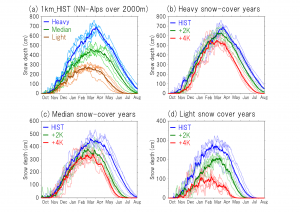Mesoscale research covers atmospheric motions that range from 2 to 2,000 km in horizontal scale. These circulations usually vary from typhoons, fronts, convection, snowfall, and etc.
The prediction of daily weather forecasts is also included in this field of research as the weather is mainly influenced by mesoscale flow. In our laboratory, a local weather prediction system (Down-Scaling Simulation System: DS3) in Miyagi Prefecture was developed using the Japan Meteorological Agency Nonhydrostatic Model (JMA-NHM) model. Further research is conducted to improve the modeling system.
Research topics in this field that are covered in our laboratory include, but are not limited to the following:
Yamase

A low-level cool easterly wind moving towards northern Japan, also known as Yamase, occurs during the rainy season (around early summer) in the Tohoku region. These cool winds keep the surface air temperature low in the daytime by reducing solar insolation which affects the radiation balance and is followed by a wide range of low-level clouds. However, these low-level clouds are so small (~hundreds of meters scale). In order to investigate its formation and development processes, it requires observational surveys and numerical analyses using high-resolution models.
Studies on Yamase have drawn great attention among researchers as this phenomenon has devastating effects on agricultural production over the Tohoku region.
Further reading:
Shimada, T., Sawada, M., & Iwasaki, T. (2014). Indices of cool summer climate in northern Japan: Yamase indices. Journal of the Meteorological Society of Japan. Ser. II, 92(1), 17-35.
Ecosystem model (land carbon cycle)
The terrestrial plants and soil exchange CO2 with the atmosphere through photosynthesis and respiration. It is important to know how the carbon balance is affected in response to climate change as it can influence productions (e.g., food and other agricultural supplies) essential in society.
Land carbon cycle models can be used to evaluate changes in the terrestrial carbon cycle by numerically simulating the energy, water, and carbon exchanges between the land surface and the atmosphere.
In our laboratory, the Eco-physiological And Mechanistic approaches using Satellite data (BEAMS) model is used to simulate carbon, energy, and water fluxes. The BEAMS model can provide estimates on the amount of CO2 concentration absorbed by the land, ranging from past to future timescale. This field of research involves complex processes, but studies are continually conducted to further develop the model and to improve the representation of several exchange processes.
Further reading:
Sasai, T., Obikawa, H., Murakami, K., Kato, S., Matsunaga, T., & Nemani, R. R. (2016). Estimation of net ecosystem production in Asia using the diagnostic‐type ecosystem model with a 10 km grid‐scale resolution. Journal of Geophysical Research: Biogeosciences, 121(6), 1484-1502.
Local weather
In realistically simulating the local weather, features such as topography, land-ocean contrast, etc. should be properly represented. In dealing with this, our laboratory uses non-hydrostatic models (JMA-NHM, WRF, etc.) in performing high-resolution (~5-km or less) simulations to reproduce atmospheric phenomena such as torrential rains, typhoons, coastal fronts, snowfall, etc.
Numerical experiments (e.g., sensitivity tests on terrain, surface roughness, etc.) are also carried out to investigate the physical parameters that influence the local weather phenomena.
Further reading:
Ohara, R., Iwasaki, T., & Yamazaki, T. (2021). Impacts of Evaporative Cooling from Raindrops on the Frontal Heavy Rainfall Formation over Western Japan on 5-8 July 2018. Journal of the Meteorological Society of Japan. Ser. II.
Land surface processes
The land surface plays an important role in the climate system. As the land surface exchanges energy and mass with the atmosphere, it affects the atmospheric conditions in specific regions in a form of feedback. The land surface simply takes part as a regulator.
In our laboratory, we use land surface processes models to understand the wettability of plant leaves, forecast the risk of crop diseases, and analyze the land surface processes in certain regions (e.g., Siberia).
Further reading:
Yamazaki, T., Kato, K., Ito, T., Nakai, T., Matsumoto, K., Miki, N., Park, H., & Ohta, T. (2013). A common stomatal parameter set used to simulate the energy and water balance over boreal and temperate forests. Journal of the Meteorological Society of Japan. Ser. II, 91(3), 273-285.
Snow and ice

(a) Snow depth in 1km_HIST experiment. Heavy (blue), median (green), and light snow-cover years (brown) in 1km_HIST experiment. (b) Heavy, (c) median, and (d) light snow-cover years in 1km_HIST, 1km_2K, and 1km_4K experiments. Blue, green, and red lines represent 1km_HIST, 1km_2K, and 1km_4K experiments, respectively. Thin lines represent individual simulations, and thick lines represent the five-year mean in each condition (Kawase et al., 2020)
The Earth has different types of snow and ice depending on the environmental conditions. They can be in the form of snowfall, ice fog, ice sheets, glaciers, etc. There has been continuous interest in snow and ice research as it has a large influence on the heat and moisture exchange between the land surface and the atmosphere. The snow and ice on the surface reflect an immense amount of solar radiation and absorb heat energy (melting process).
In our laboratory, we perform numerical simulations to analyze phenomena related to snow and ice (e.g., heavy snow, freezing rain events, and water resources), to deepen our understanding of the atmospheric processes related to it. We are also interested in determining the effects of future changes in the climate on the snow cover.
Further reading:
Kawase, H., Yamazaki, T., Sugimoto, S., Sasai, T., Ito, R., Hamada, T., ... & Sasaki, H. (2020). Changes in extremely heavy and light snow-cover winters due to global warming over high mountainous areas in central Japan. Progress in Earth and Planetary Science, 7(1), 1-17.
